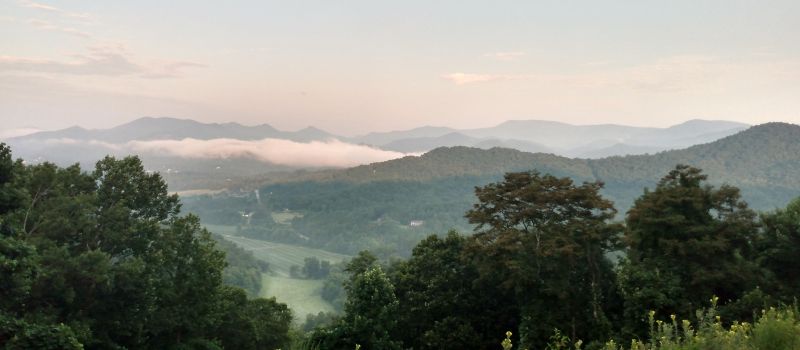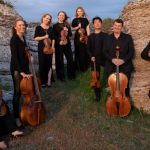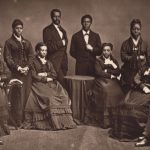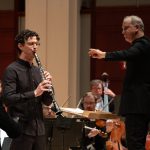August 1, 2021
Village Green Commons
Highlands, North Carolina
Helen Hwaya Kim, violin; Zuill Bailey, cello; Jasmine Arakawa, piano.
SAINT-SAËNS: Havanaise, Op. 83
SARASTE: Carmen Fantasy
TCHAIKOVSKY: Variations on a Rococo Theme, Op. 33
BRAHMS: Double Concerto in A minor, Op. 102
MARK GRESHAM | 6 AUG 2021
Written in 1887 for Cuban violinist Rafael Díaz Albertini, Camille Saint-Saëns’ Havanaise in E major, Op. 83, is one of the standards of concertante violin repertoire. Violinist Helen Hwaya Kim chose it to open Sunday’s “Concerto Night” concert at the Highlands-Cashiers Chamber Music Festival, with pianist Jasmine Arakawa making her Festival debut as collaborative pianist of the evening.
There was a time in the 19th and early 20th centuries when it was popular to play concerto repertoire with a piano accompaniment in concert if only for the simple fact that in many smaller cities and towns, full orchestras simply were not locally available. The piano had become a fixture in every parlor in homes of social standing. It was the means by which orchestral music was learned and studied in transcriptions for piano four hands, and how opera arias, concertos and other concertante works could be heard live absent an orchestra. That was the premise for the Festival’s “Concerto Night”-themed concert on Sunday in Highlands – which was repeated in Cashiers the following evening – despite the fact that only on work on the program, Brahms’ Double Concerto, was an actual full-fledged concerto.
A havanaise, or habanera, is a style of 19th-century Cuban contradance music in slow duple meter that features a syncopated rhythm and a strong downbeat. Saint-Saëns freely develops the style in a kind of rondo based on this characteristic rhythm, with lyrical interludes intervening between more virtuosic episodes.
The Havanaise served as an excellent setup for their next piece on the program, the Carmen Fantasy, Op. 25 by violinist-composer Pablo Sarasate. Based on themes from Georges Bizet’s opera, Carmen, it is one of Sarasate’s best known works and one of the most challenging and technically demanding in violin repertoire. Originally for violin with orchestra, an edition with piano accompaniment was published in 1882. As Saraste wrote it, the piece contains (in order) adaptations of the Aragonaise, the Habanera, an interlude, the Seguidilla, and the Gypsy Dance. A performance takes approximately 12 minutes.
The version Ms. Kim played in this concert was a little different from Saraste’s original. It was taught to her at Juilliard by her teacher, Dorothy DeLay. Notable violinists Sarah Chang, Gil Shaham and Midori, for examples, also play this exact same version, which inserts a movement from Franz Waxman’s Carmen Fantasie between the Aragonaise and the Habanera, and eliminates the interlude that follows, jumping straight into the Seguidilla instead, followed by the final Gypsy Dance.
However, in this performance the audience erupted into enthusiastic applause immediately after the popular Habanera, and a smiling Kim had to hold up her hand and tell them, “Wait, it’s not over!”
The best was indeed yet to come in the latter part of the piece: we got a display of technical virtuosity from Kim that gave the impression of doing the impossible while emotionally on fire. It was a sizzling conclusion to the Fantasy, which earned a well-deserved standing ovation.

Morning view from Dillard Road that winds its way up to Highlands, NC from Dillard, GA. (credit: Mark Gresham)
Tchaikovsky’s Variations on a Rococo Theme, Op. 33 for cello and orchestra drew inspiration from the “classical” style of Mozart, whose music Tchaikovsky admired. The theme itself is not Rococo in origin, but is Tchaikovsky’s own. The piece is the closest Tchaikovsky would ever come to writing an actual cello concerto.
Here again, we have Ms. Arakawa playing a reduction of the orchestra part on piano. But as with Ms. Kim did with the Fantasy cellist Zuill Bailey chose not to play the less-known original version, rather the “amended” edition by its dedicatee, Wilhelm Fitzenhagen, the German principal cellist at the Moscow Conservatory, for whom it was written. Fitzenhagen himself played Tchaikovsky’s original only once. He implemented his own changes, edits and re-ordering of movements thereafter, to which the chronically insecure composer himself assented. Tchaikovsky’s original would not surface again in public performance until 1941. Most cellists today, like Mr. Bailey, still prefer and play the Fitzenhagen version.
Too often the piece is approached in a rather cool and sedate way. Bailey’s more impassioned approach to playing it, however, is not overdone. It ascends to virtuoso levels in passages, for certain, but Bailey does not take a tepid approach to the rest. That’s good, because however “classical” the composer’s original inspiration, and however impacted by Fitzenhagen’s amendments, the Rococo Variations remain, after all, Tchaikovsky at the core.
The Double Concerto in A minor, Op. 102, composed in 1887, was Brahms’ final work for orchestra. An excellent performance demands a pair of brilliant, well-matched soloists. With orchestra replaced by piano, the challenge for the pianist is one of approaching the part in a way that makes the piece work as if a Piano Trio. This was well-handled by Ms. Arakawa. Throughout the concert, she did not overwhelm either of the soloists, although a more resonant, full-sized grand piano might have helped in passages in the Brahms Double which were “purely orchestral” passages in terms of color and presence of the instrument’s sound. But that is a fact with which all pianists must ultimately deal: We typically play the instruments we are given, in the contexts we are given. Part of the art is what we do with that, and Arakawa was fully able to deal with it.
As for the well-matched soloists, we got that. That has a story behind it, because Kim and Bailey went to Juilliard at the same time. They played chamber music together back then. It showed in what seemed their ease of musical interplay. What hearing this performance now begs is for these three musicians to play one of the three actual piano trios of Brahms in some future concert. (Or perhaps something more adventurous for piano trio instead?)
All in all, it was a fabulous concert that left listeners more than satisfied. Definitely worth the trip from Atlanta to hear it.
The Festival concludes with its Gershon/Cohn Gala this Sunday, August 8. For more information: h-cmusicfestival.org ■
RECENT POSTS
 Tine Thing Helseth brings fire and finesse to trumpet concertos by Arutiunian, Penderecki, and Weinberg • 24 Oct 2025
Tine Thing Helseth brings fire and finesse to trumpet concertos by Arutiunian, Penderecki, and Weinberg • 24 Oct 2025 Camerata Nordica Octet brings Scandinavian color and classical clarity to Hodgson Hall • 21 Oct 2025
Camerata Nordica Octet brings Scandinavian color and classical clarity to Hodgson Hall • 21 Oct 2025




.png)